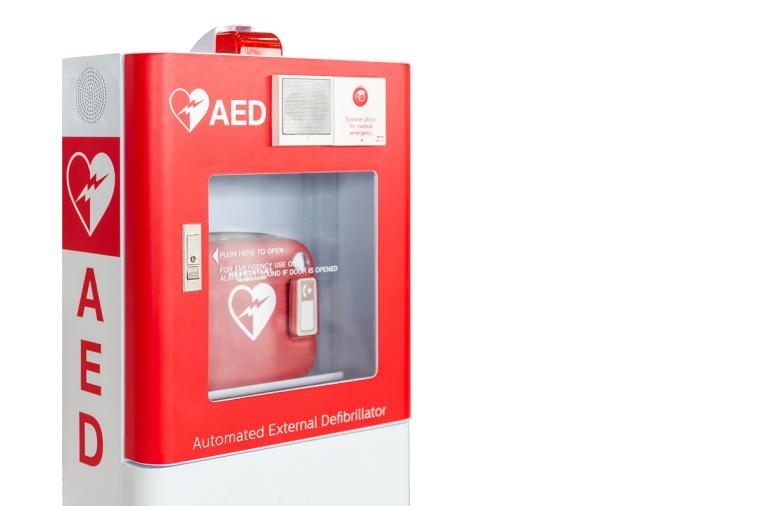
When Buffalo Bills safety Damar Hamlin suffered cardiac arrest on Jan. 2 at Paycor Stadium in Cincinnati — with millions of people watching on Monday Night Football — the incident served as an emergency preparedness wake-up call to youth sports organizations and other sports and recreation groups in communities all over the country.
For example, while many schools in Ohio already have AEDS, they are not mandated. A bill in that would have required automated external defibrillators (AEDs) be available at all Ohio schools failed in 2022. But State Representative Richard Brown, a Democrat, now said he plans to revive the legislation — hopefully with a Republican as a joint sponsor — according to Local12.com in Cincinnati.
When asked if the bill also would require drills to help facility staff respond to a cardiac arrest incident or make coaches always carry portable AEDs with them, Brown noted the merit of both suggestions. “My goal with this legislation is to save a child’s life,” he told Local12.com. “But, I also want it to be passed. And if you try to bite off too big of a bite on something, it frequently doesn’t pass the legislature.”
According to the Centers for Disease Control and Prevention, all 50 states have laws in place requiring AEDs in targeted locations, but there is no federal law requiring onsite AEDs in designated spaces. As of 2021, only 17 states had laws on the books requiring AEDs on school campuses, and the likelihood of such devices being available at other facilities — such as parks, sports complexes and recreation centers — isn’t always known.
Which is why we might be seeing more gestures by professional sports teams like the NFL’s New Orleans Saints and the NBA’s New Orleans Pelicans. Gayle Benson, owner of both franchises, recently donated AEDs to the City of New Orleans and Jefferson Parish. City officials plan to make the 40 devices available at 35 parks, three baseball fields and two football fields. Jefferson Parish, meanwhile, is expected to receive 27 AEDs for use in its facilities.
“In light of the horrible events involving … Hamlin, we felt it was urgent that we reach out to our local recreational facilities to determine their needs,” Benson said in written statements announcing the donations. “NFL games have the most advanced medical staff and equipment on hand, and we believe this needs to be replicated as best as possible on the youth sports level.”
AED donations in other municipalities are coming in from local groups such as the Wear Red For Women committee of the Bothwell Regional Health Center Foundation in Sedalia, Mo., which presented several AEDs recently to multiple organizations — including Sedalia Parks and Recreation and the Smithton Youth Sports Complex. According to KSISRadio.com, “funds to purchase the device[s] were raised during the 2022 Wear Red for Women luncheon and auction. The committee’s goal is to have AEDs in every place people work, learn, play or pray in Sedalia and Pettis County. Since the inception of the luncheon event in 2020, 47 AEDs have been placed in or committed to various locations.”
Interest in learning CPR has increased, too. Consider the scene at Harford County’s Millstad Center in Joppatowne, Md., where a training session led by representatives of Fallston Girls Lacrosse taught attendees several emergency procedures — including how to administer CPR and how to use an AED. (The club recently received donated AEDs.)
“I’m out on the field. I’m not trained. I’m getting trained today,” Jenni Rinehart, president of the lacrosse club, told WBALTV.com. “What if I’m there by myself? What if I’m the only coach, the sole coach on the field? How do I address these needs should it arrive?”
“There was a 13-year-old girl on Dec. 20 here in Harford County that had a cardiac arrest at a local ice rink, and she was saved by the quick-acting staff that did immediate CPR and did defibrillate her, and today she’s alive because of it,” added Amanda Joy, an emergency room physician assistant and paramedic. “And then, of course, Damar Hamlin. The world watched as he got CPR, was shocked with the AED, and his life was saved.”
Indeed, CPR is vital in the early moments of an emergency situation, as Heather Claussen, director of allied health programs at Northeast Community College in Norfolk, Neb., told the Norfolk Daily News. The college held an already-scheduled CPR/AED training class less than a week after Hamlin collapsed on the field.
 “You have about 10 minutes from the time that a person goes down, and that would be that brain damage is likely,” she said. “So we really want to be starting CPR within a two- to four-minute timeframe. If we can get people who are on the scene to start CPR chest compressions immediately, the chances of survival go up greatly in that first two to four minutes.”
“You have about 10 minutes from the time that a person goes down, and that would be that brain damage is likely,” she said. “So we really want to be starting CPR within a two- to four-minute timeframe. If we can get people who are on the scene to start CPR chest compressions immediately, the chances of survival go up greatly in that first two to four minutes.”
CPR skills and AED units aren’t just needed in sports and recreation places. That’s why emergency services personnel in North Carolina’s Watauga County are planning a free CPR/AED training course for local residents — citing “renewed community interest” after what happened to Hamlin, whose recovery continues.
“CPR is the single most important factor in patient survival in sudden cardiac arrest,” Watauga County Emergency Services director Will Holt told the Watauga Democrat. “Immediate, effective CPR — specifically chest compressions — can double or triple the chance of survival and requires minimal training for the layperson to do.”

